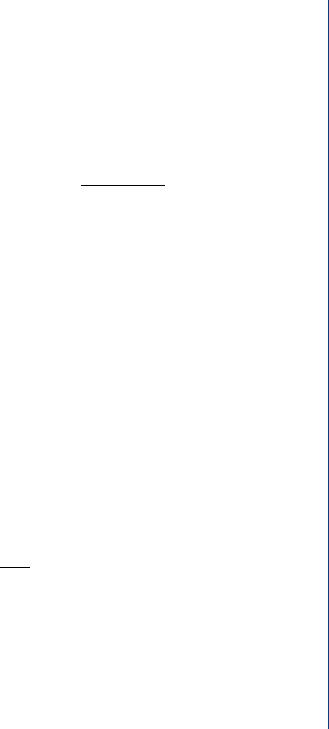
Basic Probability Theory for Biomedical Engineers - JohnD. Enderle
.pdf
INTRODUCTION 21
Proof. We note that the first component of the sample can have any of n values, the second can have any of n − 1 values, the j th component can have any of n − ( j − 1) values. Consequently,
Pn,k = n(n − 1) · · · (n − k + 1).
Example1.2.10. From a rural community of 40 people, four people are selected to serve on a committee. Those selected are to serve as president, vice president, treasurer, and secretary. Find the number of sample points in S.
Solution. Since the order of selection is important, we compute the number of sample points in S using the formula for permutations with n = 40 and k = 4 as
40!
= (40 − 4)! = 40 × 39 × 38 × 37 = 2,193,360. It is important to emphasize that sampling either with or without replacement yields an ordered
list: samples consisting of the same elements occurring in a different order are counted as distinct samples.
Next, consider a case in which some of the n objects are identical and indistinguishable.
Theorem 1.2.3. The number of distinct permutations of n objects taken n at a time in which n1 are of one kind, n2 are of a second kind, . . . , nk are of a kth kind, is
Pn:n1,n2,...,nk = |
n! |
(1.41) |
|
|
, |
||
n1! n2! · · · nk ! |
|||
where |
|
|
|
n = |
k |
|
|
ni . |
(1.42) |
||
i=1 |
|
||
Proof. This result can be verified by noting that there are n! ways of ordering n things (n! samples without replacement from n things). We must divide this by n1! (the number of ways of ordering n1 things), then by n2!, etc. For example, if A = {a1, a2, a3, b}, then the number of permutations taken 4 at a time is 4!. If the subscripts are disregarded, then a1a2ba3 is identical to a1a3ba2, a2a3ba1, a3a1ba2, a2a1ba3 and a3a2ba1, and can not be included as unique permutations. In this example then, the total number of permutations (4!) is divided by the number of permutations of the three As and equals 4!/3!. Thus, whenever a number of identical objects form part of a sample, the number of total permutations of all the objects is divided by the product of the number of permutations due to each of the identical objects.
Example 1.2.11. How many different 8-bit computer words can be formed from five zeros and three
ones?

22 BASIC PROBABILITY THEORY FOR BIOMEDICAL ENGINEERS
Solution. The total number of distinct permutations or arrangements is
P8:5,3 = |
8! |
= 56. |
|
5! 3! |
Combinations
Definition 1.2.3. A combination is a set of elements without repetition and without regard to order.
Theorem 1.2.4. The number of combinations of n things taken k at a time is given by
|
Cn,k = |
Pn,k |
= |
n |
= |
n! |
(1.43) |
||
|
|
|
|
. |
|
||||
|
k! |
k |
(n − k)! k! |
||||||
Proof. We have |
|
|
|
|
|
|
|
|
|
Cn,k = |
number of permutations of n things taken k at a time |
|
|||||||
|
|
|
|
|
. |
||||
|
|
|
|
|
|||||
number of ways of reordering k things |
|
||||||||
Note that Cn,k = Pn:n−k,k .
Example1.2.12. From a rural community of 40 people, four people are selected to serve on a committee. Those selected are to serve as president, vice president, treasurer, and secretary. Find the number of committees that can be formed.
Solution. There are C40,4 ways of choosing an unordered group of four people from the community of forty. In addition, there are 4! ways of reordering (assigning offices) each group of four; consequently, there are
4! × C40,4 = 4! |
40! |
|
= 40 × 39 × 38 × 37 = 2,193,360 |
(40 − 4)! 4! |
|||
committees. |
|
|
|
One useful application of the number of combinations is the proof of the Binomial Theorem.
Theorem 1.2.5 (Binomial Theorem). Let x and y be real numbers and let n be a positive integer. Then
n
(x + y)n =
k=0
Proof. We have
n |
xn−k yk . |
(1.44) |
|
k |
|||
|
|
(x + y)n = (x + y)(x + y) · · · (x + y),
n terms

INTRODUCTION 23
a product of n sums. When the product is expanded as a sum of products, out of each term we choose either an x or a y; letting k denote the number of y’s, we then have n − k x’s to obtain a general term of the form xn−k yk . There are ( nk ) such terms. The desired result follows by summing over k = 0, 1, . . . , n.
Example 1.2.13. From four resistors and three capacitors, find the number of three component series circuits that can be formed consisting of two resistors and one capacitor. Assume each of the components is unique, and the ordering of the elements in the circuit is unimportant.
Solution. This problem consists of a sequence of three experiments. The first and second consist of drawing a resistor, and the third consists of drawing a capacitor.
One approach is to combine the first two experiments—the number of combinations of two resistors from four is C4,2 = 6. For the third experiment, the number of combinations of one capacitor from three is C3,1 = 3. We find the number of circuits that can be found with two resistors and one capacitor to be C4,2C3,1 = 6 × 3 = 18.
For another approach, consider a typical “draw” of components to be R1 R2C. R1 can be any of four values, R2 can be any of the remaining three values, and C can be any of three values—for a total number of 4 × 3 × 3 = 36 possible draws of components. There are 2! ways to reorder R1 and R2 and 1! way of reordering the capacitor C, so that we have
|
4 × 3 × 3 |
= 18 |
2! 1! |
||
possible circuits. |
|
|
As the previous example showed, solving a counting problem involves more than simply applying a formula. First, the problem must be clearly understood. The first step in the solution is establishing whether the problem involves a permutation or combination of the sample space. In many cases, it is convenient to utilize a tree diagram to subdivide the sample space into mutually exclusive parts, and to attack each of these parts individually. Typically, this simplifies the analysis sufficiently so that the previously developed formulas can be applied.
Combined Experiments
We now combine the concepts of permutations and combinations to provide a general framework for finding the number of samples (ordered lists) as well as the number of sets of elements (unordered) satisfying certain criteria.
Consider an experiment ε consisting of a sequence of the k subexperiments ε1, ε2, . . . , εk , with outcome of the ith subexperiment denoted as ζi Si , where Si denotes the outcome space

24 BASIC PROBABILITY THEORY FOR BIOMEDICAL ENGINEERS
for the ith subexperiment. We denote this combined experiment by the cartesian product:
ε = ε1 × ε2 × · · · × εk , |
(1.45) |
with outcome |
|
ζ = (ζ1, ζ2, . . . , ζk ) S |
(1.46) |
and outcome space S the cartesian product |
|
S = S1 × S2 × · · · × Sk . |
(1.47) |
In general,3 the set of outcomes Si for the ith subexperiment may depend on the outcomes ζ1, ζ2, . . . , ζi−1 which occur in the preceding subexperiments, as in sampling without replacement. The total number of possible outcomes in S is
nS = nS1 nS2 . . . nSk , |
(1.48) |
where nSi is the number of elements in Si .
For sampling with replacement from a set of n elements, let S1 denote the set of n elements,
Si = S1, nSi = n, for i = 1, 2, . . . , k. Consequently, there are |
|
nS = nk |
(1.49) |
samples of size k with replacement from a set of n objects.
For sampling without replacement from a set of n elements, let S1 denote the set of n
elements, Si = Si−1 ∩ {ζi−1}c , for i = 2, 3, . . . , k. Hence, there are |
|
nS = n × (n − 1) · · · (n − k + 1) = Pn,k |
(1.50) |
samples of size k without replacement from a set of n objects. |
|
Now, consider the set A S with |
|
A = A1 × A2 × · · · × Ak , |
(1.51) |
so that ζ A iff (if and only if ) |
|
ζi Ai Si , i = 1, 2, . . . , k. |
(1.52) |
We find easily that the total number of outcomes in A is |
|
nA = nA1 nA2 . . . nAk , |
(1.53) |
where nAi is the total number of elements in Ai , i = 1, 2, . . . , k. For reasons to be made clear later, we shall refer to this set A as a sequence event, and often denote it simply as
A = A1 A2 . . . Ak . |
(1.54) |
3Actually, Si could depend on any or all of ζ1, ζ2, . . . , ζk ; however, to simplify our treatment, we restrict attention to sequence experiments which admit a step-by-step implementation.

INTRODUCTION 25
Note that nA is the total number of outcomes in the (ordered) sequence event A.
If k1 of the Ai s are of one kind, k2 of the Ai s are of a second kind, . . . , and kr of the Ai s of the r th kind, with
r
k = ki ,
i=1
then the total number of sequence events which are equivalent to A is Pk:k1,k2,...,kr total number of (ordered) outcomes equivalent to the sequence event A is
ntot = nA × Pk:k1,k2,...,kr = k! nA1 nA2 . . . nAk .
(1.55)
so that the
(1.56)
Finally, if the ordering of the Ai s is unimportant, we find the number of distinct combinations which are equivalent to the sequence event A is
ncomb = |
ntot |
= |
nA1 nA2 . . . nAk |
, |
(1.57) |
k! |
k1! k2! . . . kr ! |
where k! is the number of ways of reordering a k-dimensional outcome.
Example 1.2.14. Five cards are dealt from a standard 52 card deck of playing cards. There are four suits (Hearts, Spades, Diamonds, and Clubs), with 13 cards in each suit (2,3,4,5,6,7,8,9,10, Jack, Queen, King, Ace). (a) How many five-card hands can be dealt? (b) How many five-card hands contain exactly two Hearts? (c) How many hands contain exactly one Jack, two Queens, and two Aces?
Solution
(a)There are P52,5 = 52 × 51 × 50 × 49 × 48 ≈ 3.12 × 108 five-card hands, counting different orderings as distinct. Since the ordering of cards in the hand is not important, there are
= P52,5 = 2598960 ≈ 2.6 × 106
5!
five-card hands that can be drawn.
(b) Consider the sequence event
A = H1 H2 X3 X4 X5,
where Hi denotes a heart on the ith draw and Xi denotes a non-heart drawn on the ith draw. There are
nA = 13 × 12 × 39 × 38 × 37 = 8554104

26 BASIC PROBABILITY THEORY FOR BIOMEDICAL ENGINEERS
outcomes in the sequence event A. Of the five cards, two are of type heart, and three are of type non-heart, for a total of
ntot = nA P5:2,3 = nA × 10 = 85541040
outcomes equivalent to those in A. Finally, since the ordering of cards in a hand is unimportant, we find that there are
|
nA |
= |
13 × 12 × 39 × 38 × 37 |
= 712842 |
|
|||||||
|
|
|
|
|
|
|
|
|
|
|||
2! 3! |
|
|
2! 3! |
|
|
|||||||
hands with exactly two hearts. |
|
|
|
|
|
|
|
|
||||
An alternative is to compute |
|
|
|
|
|
|
|
|
||||
C13,2C39,3 = |
13 × 12 39 × 38 × 37 |
= 712842 |
. |
|||||||||
|
2! |
|
|
3! |
|
|
||||||
(c) Consider the sequence event
B = J1 Q2 Q3 A4 A5.
Arguing as in (b), we find that there are
4 × 4 × 3 × 4 × 3 = 144 1! 2! 2!
hands with one Jack, two Queens, and two Aces. An alternative is to compute
C4,1C4,2C4,2 = |
4 |
4 × 3 |
4 × 3 |
= 144 |
. |
|
|
1 |
2 2 |
||||||
|
|||||||
Example 1.2.15. Suppose a committee of four members is to be formed from four boxers (A,B,C,D), five referees (E,F,G,H,I) and TV announcer J. Furthermore, A and B hate each other and cannot be on the same committee unless it contains a referee. How many committees can be formed?
Solution. This problem can best be solved by reducing the problem into a mutually exclusive listing of smaller problems. There are four acceptable committee compositions:
1. A is on the committee and B is not. Consider the sequence event AX2 X3 X4, where Xi consists of all previously unselected candidates except B. There are 1 × 8 × 7 × 6 outcomes in the sequence event AX2 X3 X4. Since X2, X3, and X4, are equivalent and the order is unimportant, we find that there are
1 × 8 × 7 × 6 = 56 1! 3!
distinct committees with A on the committee and B not on the committee.

INTRODUCTION 27
2.B is on the committee and A is not. This committee composition is treated as case 1 above with A and B interchanged. There are thus 56 such committees.
3.Neither A nor B is on the committee. Consider the sequence event X1 X2 X3 X4, where Xi denotes any previously unselected candidate except A or B. There are
8 × 7 × 6 × 5
0! 4!
= 70
such committees.
4.A and B are on the committee, along with at least one referee. Consider AB RX4, where X4 = {C, D, J }. There are
|
1 × 1 × 5 |
× 3 |
= 15 |
|
1! 1! 1! 1! |
|
|||
such committees with one referee. By considering AB R3 R4, there are |
|
|||
|
1 × 1 × 5 |
× 4 |
= 10 |
|
1! 1! 2! |
|
|||
distinct committees with two referees. |
|
|
|
|
Thus, the total number of acceptable committees is |
|
|||
56 + 56 + 70 + |
15 + 10 = 207. |
|
||
Example 1.2.16. A change purse contains five nickels, eight dimes, and three quarters. Find the number of ways of drawing two quarters, three dimes, and four nickels if:
(a)coins are distinct and order is important,
(b)coins are distinct and order is unimportant,
(c)coins are not distinct and order is important,
(d)coins are not distinct and order is unimportant.
Solution. Let sequence event
A = Q1 Q2 D3 D4 D5 N6 N7 N8 N9.
Sequence event A represents one way to obtain the required collection of coins. There are a total of 3 × 2 × 8 × 7 × 6 × 5 × 4 × 3 × 2 = 241920 outcomes in A. There are
9! |
= |
|
9 × 8 |
× 7 |
× 6 × 5 |
= 2 × 630 = 1260 |
|
2! 3! 4! |
2 |
× 3 |
× 2 |
||||
|
|
||||||
ways to reorder the different types of coins in A, so that there are a total of 1260 sequence events which, like A, contain two quarters, three dimes, and four nickels.

28BASIC PROBABILITY THEORY FOR BIOMEDICAL ENGINEERS
(a)We find that there are
|
|
|
|
9! |
|
|
≈ 3.048 × 108 |
||||
|
241920 × |
|
|
||||||||
|
2! 3! 4! |
||||||||||
|
ways to draw two quarters, three dimes, and four nickels if the coins are distinct and |
||||||||||
|
order is important. |
|
|
|
|
|
|
|
|
|
|
(b) |
There are 9! ways to reorder nine distinct items, so that there are |
||||||||||
|
241920 |
|
9! |
|
241920 |
||||||
|
|
|
× |
|
|
|
= |
|
= 840 |
||
|
9! |
2! 3! 4! |
2! 3! 4! |
||||||||
|
ways to draw two quarters, three dimes, and four nickels if the coins are distinct and |
||||||||||
|
order is unimportant. |
|
|
|
|
|
|
|
|
|
|
(c) |
Sequence event A represents one way to obtain the required collection of coins. There |
||||||||||
|
are |
|
|
|
|
|
|
|
|
|
|
|
|
|
|
9! |
|
= 1260 |
|
||||
|
|
|
|
|
|
|
|||||
|
|
|
|
2! 3! 4! |
|
|
|||||
|
ways to reorder the different types of coins in A, so that there are 1260 ways to draw |
||||||||||
|
two quarters, three dimes, and four nickels if the coins are not distinct and order is |
||||||||||
|
important. |
|
|
|
|
|
|
|
|
|
|
(d) |
There is 1 way to draw two quarters, three dimes, and four nickels if the coins are not |
||||||||||
|
distinct and order is unimportant. |
|
|
|
|
|
|
|
|
||
Drill Problem 1.2.1. An urn contains four balls labeled 0, 1, 2, 3. Two balls are selected one after the other without replacement. Enumerate the sample space using both a tree diagram and a coordinate system.
Answers: 12, 12.
Drill Problem 1.2.2. An urn contains three balls labeled 0, 1, 2. Reach in and draw one ball to determine how many times a coin is to be flipped. Enumerate the sample space with a tree diagram.
Answer: 7.
Drill Problem 1.2.3. Professor S. Rensselaer teaches a course in probability theory. She is a kindhearted but very tricky old lady who likes to give many unannounced quizzes during the week. She determines the number of quizzes each week by tossing a fair tetrahedral die with faces labeled 1, 2, 3, 4. The more quizzes she gives, however, the less time she has to assign and grade homework problems. If Ms. Rensselaer is to give L quizzes during the week, then she will assign from 1 to 5-L homework problems. Enumerate the sample space describing the number of quizzes and homework problems she gives each week.
Answer: 10.

INTRODUCTION 29
Drill Problem 1.2.4. Determine the number of 8-bit computer words that can be formed if: (a) the first character is zero, (b) the last two characters are one, (c) the first character is zero and the last two characters are one, (d) all of the characters are zero.
Answers: 1, 32, 64, 128.
Drill Problem 1.2.5. Determine the number of even three digit numbers that can be formed from S if each digit can be used only once and (a) S = {1, 2, 4, 7}; (b) S = {2, 4, 6, 8}; (c ) S = {1, 2, 3, 5, 7, 8, 9}; (d )S = {1, 3, 5, 7, 9}.
Answers: 24, 12, 60, 0.
Drill Problem 1.2.6. Eight students A through H enter a student paper contest in which awards are given for first, second and third place. Determine the number of finishes (a) possible; (b) if student C is awarded first place; (c) if students C and D are given an award; (d) if students C or D are given an award, but not both.
Answers: 336, 42, 36, 180.
Drill Problem 1.2.7. Determine the number of 8-bit computer words containing (a) three zeros;
(b) three zeros, given the first bit is one; (c) two zeros, given the first three bits are one; (d) more zeros than ones.
Answers: 35, 56, 93, 10.
Drill Problem 1.2.8. Suppose a committee consisting of three members is to be formed from five men and three women. How many committees (a) can be formed; (b) can be formed with two women and one man; (c) can be formed with one woman and two men if a certain man must be on the committee?
Answers: 15, 56, 12.
Drill Problem 1.2.9. A college plays eight conference and two nonconference football games during a season. Determine the number of ways the team may end the season with (a) eight wins and two losses; (b) three wins, six losses, and one tie; (c) at least seven wins and no ties; (d) three wins in their first four games and two wins and three losses in the remaining games.
Answers: 840, 176, 480, 45.
1.3DEFINITION OF PROBABILITY
Up to this point, we have discussed an experiment and the outcome space for the experiment. We have devoted some effort to evaluating the number of specific types of outcomes in the case of a discrete outcome space. To a large extent, probability theory provides analytical methods

30 BASIC PROBABILITY THEORY FOR BIOMEDICAL ENGINEERS
for assigning and/or computing the “likelihood” that various “phenomena” associated with the experiment occur. Since the experimental outcome space is the set of all possible outcomes of the experiment, it is clear that any phenomenon for which we have an interest may be considered to be some subset of the outcome space. We will henceforth refer to such a subset of S as an event. We say that event A has occurred if the experimental outcome ζ A. Thus, if A S is an event we denote the probability (or likelihood) that event A has occurred as P (A). While any subset of S is a potential event—we will find that a large simplification occurs when we investigate only those events in which we have some interest. Let’s agree at the outset that P (A) is a real number between 0 and 1, with P (A) = 0 meaning that the event A is extremely unlikely to occur and P (A) = 1 meaning that the event A is almost certain to occur.
Several approaches to probability theory have been taken. Four approaches will be discussed here: classical, relative frequency, personal probability and axiomatic.
1.3.1Classical
The classical approach to probability evolved from the gambling dens of Europe in the 1600s. It is based on the idea that any experiment can be broken down into a fine enough space so that each single outcome is equally likely. All events are then made up of the mutually exclusive outcomes. Thus, if the total number of outcomes is N and the event A occurs for NA of these outcomes, the classical approach defines the probability of A,
P (A) = |
NA |
(1.58) |
N . |
This definition suffers from an obvious fault of being circular. The statement of being “equally likely” is actually an assumption of certain probabilities. Despite this and other faults, the classical definition works well for a certain class of problems that come from games of chance or are similar in nature to games of chance. We will use the classical definition in assuming certain probabilities in many of our examples and problems, but we will not develop a theory of probability from it.
1.3.2Relative Frequency
The relative frequency definition of probability is based on observation or experimental evidence and not on prior knowledge. If an experiment is repeated N times and a certain event A occurs in NA of the trials, then the probability of A is defined to be
P (A) = Nlim |
NA |
. |
(1.59) |
|
|||
→∞ |
N |
|
|
For example, if a six-sided die is rolled a large number of times and the numbers on the face of the die come up in approximately equal proportions, then we could say that the
